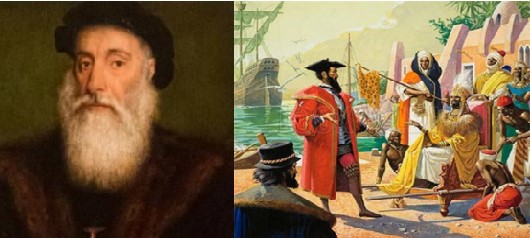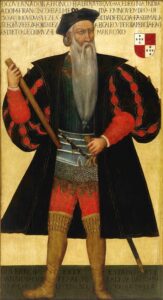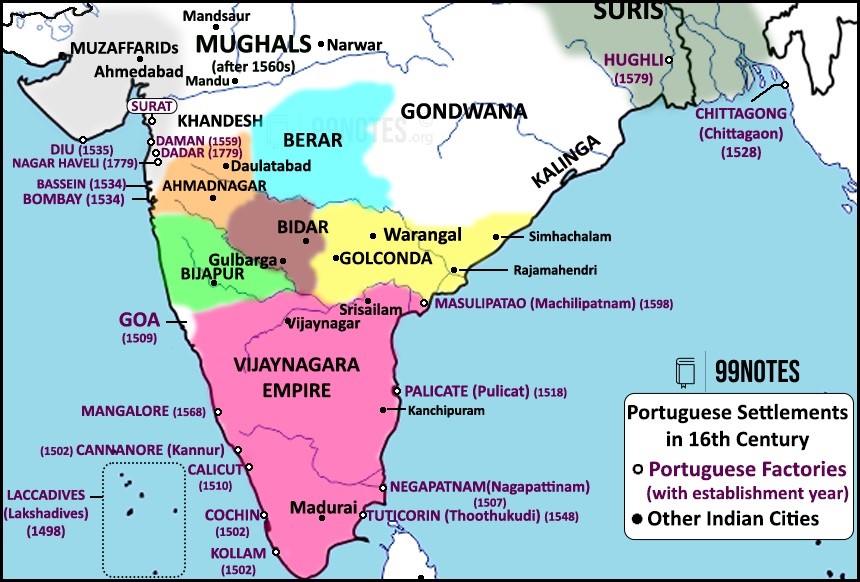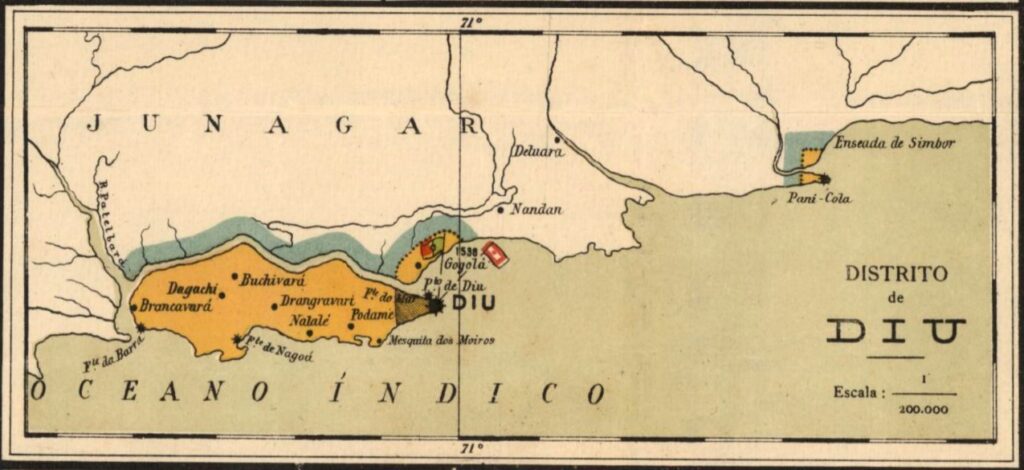Advent of Portuguese in India- UPSC Notes
Portuguese in india
- Portuguese in india
- Factors Which Brought the Portuguese To India
- First Portuguese Factory in India
- The Portugal Arrival
- Expansion of the Portuguese
- Portuguese Viceroy in India:
- The military strategy of the Portuguese
- Portuguese Impact on Trade and Society
- The Decline of the Portuguese
- Explore additional significant articles on Medieval Indian History listed in the table below:
The Portuguese were the first Europeans to discover a direct maritime route to India and thereby solve the age-old problem of circumventing the Arab Traders. On May 20, 1498, Portuguese merchant Vasco da Gama became the first merchant to arrive in Calicut, an important seaport in South India.
 Vasco Da Gama in the court of zamorin(picture source unknown)
Vasco Da Gama in the court of zamorin(picture source unknown)
Factors Which Brought the Portuguese To India
- Rising demands for luxurious items in Europe: Since Roman times, there had been a consistent demand for goods from the east, including silk from China and spices and chemicals from India and Southeast Asia.
- Fall of Constantinople: With the fall of Constantinople to the Ottoman Turks in 1453 and Syria and Egypt later, the merchandise from India went to the European markets through Arab Muslim intermediaries.
- These circumstances compelled Europeans to find a sea route to India to get rid of these intermediaries.
- Logistical and human resources: Spanish and Portugal‘s discoverers were aided with money and men by northern Europeans. The ships and technical knowledge were provided by the merchants of Genoa(a port in Italy).
- Royal patronage: Portuguese ruler Dom Henrique, called Henry the Navigator, is considered the main initiator of Portuguese discovery.
-
- He had two main objectives, to oust Arabs as well as his European rivals and Diminish the growing power of Turks by converting the ‘heathens’ of Asia and Africa to Christianity, for which he got the support of the Pope.
- Age of the Renaissance: Renaissance age played a role in stirring the idea of exploring the Easteast and other unexplored areas.
- Treaty of Tordesillas: Portugal and Spain agreed in the 1494 Treaty of Tordesillas that all new land discovered to the west of 46OW longitude would be colonised by Spain, and all land to the east of it shall belong to Portugal. Thus, the Portugal Navy remained the sole European power which had got the unrestricted licence to explore the routes of the Indian Oceans.
First Portuguese Factory in India
The first Portuguese factory in India was established in 1502 at Cochin, on the Malabar Coast, marking the beginning of European colonial trade dominance in Asia. Facilitated by Vasco da Gama’s voyage to India in 1498, this trading post became a cornerstone for the Portuguese in expanding their spice trade network. It symbolized not only the advent of European colonial aspirations but also a new era in Indo-European trade relations, profoundly impacting the socio-economic landscape of the region.
The Portugal Arrival
- Vasco Da Gama, led by a Gujarati pilot named Abdul Majid, arrived at Calicut in May 1498.
- He was granted a friendly reception by the ruler of Calicut, Zamorin (Samuthiri).
- The arrival of the Portuguese led to apprehension among the Arabs, who until now had dominated the trade activities on the Malabar coast.
- The Portuguese, from the beginning, wanted to monopolise the highly profitable eastern trade by marginalising their competitors, especially the Arabs. Therefore, the Portuguese rulers treated Eastern trade as a royal monopoly, excluding rival nations in Europe and Asia and private Portuguese traders.
Portuguese Factories in India:
- In 1500 Pedro Alvarez Cabral arrived at Calicut and negotiated to establish Portuguese first factory in India. However, when locals attacked his factory in Calicut, he retaliated by seizing several Arab ships and killing their crew.
- Vasco Da Gama returned in 1501, but this time the Zamorin declined to give special favours to the Portuguese because of their ferocious hostility with the Arabs. He established a trading factory at Cannanore.
- Gradually, Calicut, Cannanore and Cochin became the important trading centres of the Portuguese.
- They also started fortifying their factories on the pretext of protection.
 Portuguese Fortress of Cochin(public domain)
Portuguese Fortress of Cochin(public domain)
Expansion of the Portuguese
| 1498 | * Arrival of Vasco Da Gama at Calicut. |
| 1500 | * Establishment of their first Portuguese factory in India at Calicut. * The Second Portuguese Factory in India was established in coachin (Present day- Kochi) |
| 1501 | * Vasco Da Gama came for the second time and established the third Portuguese factory in India at Cannanore. |
| 1505 | * The Portuguese king appointed Francisco De Almeida as the governor of India. He siezed Aden, Ormuz and Malacca. |
| 1505-09 | 1. In a series of skirmishes, Almeda had to fight a combined strength of the Sultan of Egypt and the ruler of Gujarat. Almeida launched a Blue Water Policy (Cartaze system) to dominate the Indian Ocean. |
| 1509-15 | * Governor Albuquerque became governor. He immediately started setting up forts at various strategic places in Asia and Africa and introduced a permit system for other ships in the region.
* Albuquerque acquired Goa from the Sultan of Bijapur. |
| 1529-38 | * Nino Da Cunha shifted the headquarter from Cochin to Goa. He expanded into Bengal too.
* In 1531, the Sultan of Gujarat, Bahadur Shah, allied with the Ottoman Turks to attack the Portuguese territory of Daman and Diu with limited success. However, by 1534, a Treaty of Bassein was agreed upon between Cunha and Bahadur Shan, wherein the Portuguese got Bassein in exchange for help against Humayun. |
The gist of Portuguese expansion in India
Portuguese Viceroy in India:
1. Francisco De Almeida
- In 1505, the Portuguese king appointed Francisco De Almeida as the Viceroy of India, where he served till 1509.
- Francisco De Almeida was the first Portuguese Viceroy in India.
- He entrusted him with protecting Portuguese interests, consolidating their position in India and destroying Muslim trade by seizing Aden, Ormuz and Malacca.
- Alarmed at the growing strength of the Portuguese, the Sultan of Egypt sent a fleet toward India in 1507. It was also joined by a contingent of ships belonging to the ruler of Gujarat.
- Initially, the Portuguese were defeated by the combined army in the naval battle of Diu and the son of the Portuguese governor Almeida was killed. However, the following year in 1509, the Portuguese routed the combined fleet.
- Almeida had the vision to dominate the Indian Ocean, and his policy was known as the Blue Water Policy (Cartaze system).
Blue Water Policy:
The Blue Water Policy is a maritime strategy that emphasizes the use of Naval Powers to protect a nation’s interest and promote security in international waters.
2. Afonso de Albuquerque
- Albuquerque, who succeeded Almeida as the next governor, is the real founder of Portuguese power in the east. He served as the Viceroy of India between 1509 to 1515.
- He was the 2nd Portuguese viceroy of India
- He embarked upon a policy of dominating the eastern trade by setting up forts at various strategic places in Asia and Africa.
- The Portuguese under Albuquerque introduced a permit system for other ships in the region.
- He abolished Sati and encouraged the Portuguese men to take local wives.
 Afonso de Albuquerque
Afonso de Albuquerque
3. Nino Da Cunha
- Nino Da Cunha assumed the office in 1529, and one year later, he shifted the headquarter from Cochin to Goa.
- He tried to increase the Portuguese influence in Bengal by settling many Portuguese with Hooghly as their headquarters.
- There was a growing threat to the Gujarati Traders from the Portuguese. Therefore, the Sultan of Gujarat(Bahadur Shah) allied with the Ottoman Turks, who sent two officers to Sultan’s aid. In 1531, the Portuguese attacked Daman and Diu, but the Ottoman commander, Rumi Khan, pushed them back.
- However, in lieu of help against his conflict with Humayun, Bahadur Shah signed a Treaty of Bassein in 1534, in which he ceded the territory of Bassein to the Portuguese. He later tried to recover these territories but could never succeed.

The military strategy of the Portuguese
- Occupation of the Islands near the coasts: Islands could be defended well from both land and sea. For example, the fortification at Diu was so strong that neither the Muzaffarid Sultanate of Gujarat nor the Mughals could ever get control of the fort.
 District of Portuguese Diu (public domain)
District of Portuguese Diu (public domain)
- Introduction of new technologies:
-
- They were masters of ship technology and used canons and multi-decked ships. Better ships allowed them to carry heavier armaments to a farther away distance and provided them with the necessary manoeuvrability to become the master of the Indian Ocean.
- Trade was the main aim:
- Since the Portuguese were not interested in the land revenue, which was the main source of income for the Indian kingdoms, no Indian kingdom took the occupation of a small Portuguese territory very seriously.
- The Portuguese supplied ammunition and war horses to Indian kings. Therefore, Indian kings often found them to be useful partners. For example, the Vijaynagara king Krishna Deva Rai is documented to have good trade relations with Portuguese suppliers.
Portuguese Impact on Trade and Society
Despite the small territory, the Portuguese’ impact on the Indian trade and society was immense.
- The Concept of Monopolization of trade emerged:
-
- They put certain goods such as pepper, ammunition and war horse under royal monopoly and no nation, not even Portuguese private traders, were allowed to trade these goods.
- They arrogated the right to search and seize any ship to enforce these rules.
- Ships which refused to be searched could be treated as prizes of war and sunk or captured, and the men and women aboard were treated as slaves. This led to continuous friction.
- However, the Portuguese could barely change the established pattern of Asian trade networks since the Mughals and The Safavids were able to promote and safeguard the trade overland route.
- Opened up new trade routes with foreign countries:
-
- The Portuguese opened up India’s trade with Japan, from where copper and silver were obtained and the Philippines.
- Introduction of new agricultural commodities:
-
- They helped transmit several agricultural products from Central America, such as potatoes, tobacco, maise, peanut, etc.
- Rise of Christianity:
-
- They came with religious fervour to promote Christianity. Initially, they were pretty tolerant towards Hindus and persecuted Muslims, but later, Hindus were also persecuted.
- The Portuguese Jesuits made a good impression in Akbar’s court, and Rodolfo Aquaviva and Antonio Monserrate were sent to Akbar’s court at his request.
The Decline of the Portuguese
Portuguese power started declining by the 17th century despite their strong control over the seas. This was due to a series of factors:
- The advent of other European Powers:
-
- As the knowledge of the sea route to India spread, the Portuguese were followed by the Dutch and the English.
- In 1608, Captain William Hawkins arrived Surat with a letter from James I, the king of England, requesting permission to do business in India. Jahangir appointed him as a mansabdar.
- In 1612, the battle of Swally was fought between a Portuguese fleet and the English under Thomas Best, in which the Portuguese were defeated. Jahangir was incredibly impressed with the British success.
- Acts of piracy :
-
- The acts of piracy by the Portuguese and dishonest trade practices led to conflict with the Mughals.
- Introduction of the slave trade:
-
- In Hooghly, they monopolised trade and started a cruel slave trade by purchasing and seizing Hindu and Muslim children and then they were brought up as Christians.
- Shah Jahan ordered the Bengal governor Shaista Khan to oust the Portuguese from Hooghly.
- The rise of the Marathas :
-
- The rise of the Marathas also led to their decline.
- The Marathas captured Bassein and Salsette in 1739 from the Portuguese.
- Religious policy:
-
- Their religious policy antagonised Muslims and also made Hindus resentful.
- Discovery of new countries:
-
- The discovery of Brazil diverted their attention toward the west.
Conclusion:
The Impact of Portuguese settlement had only a localised impact in the territories like Goa. But its impact on the history of the Indian subcontinent wasn’t as profound as that of the British and French, which we will see later on.
Nevertheless, the Portuguese were the first Europeans to colonise an Indian territory and were the last to leave. It took until 1961 for the Indian government to re-occupy Goa, Daman, and Diu. Further, they played a crucial role in the power struggle between Vijayanagara and the Deccan sultans, the Mughals and the Marathas etc. impacting the overall power balance in the Indian subcontinent for four centuries.





